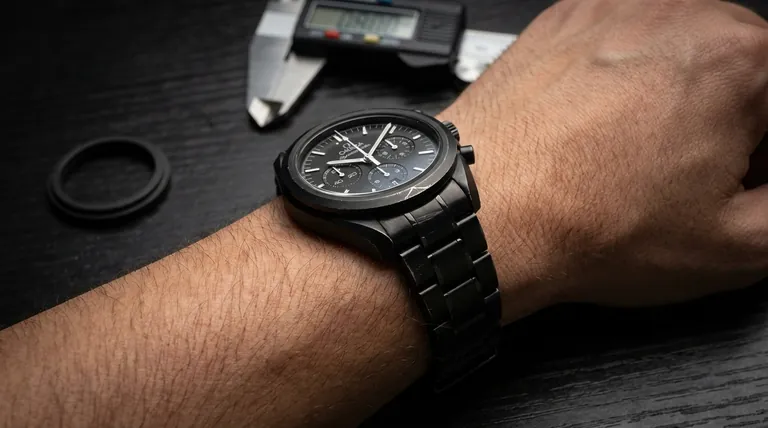In short, PVD coating does not "wear off" in the way that paint peels or flakes. This is because PVD is not a layer of paint but a microscopic film that is molecularly bonded to the watch's base metal in a high-tech vacuum process. While this bond is permanent and the surface is incredibly hard, it is not invincible and can be scratched or abraded away by significant impact or prolonged friction.
The core takeaway is that PVD coating offers superior resistance to daily scuffs and light wear compared to traditional finishes. However, it is scratch-resistant, not scratch-proof, and any damage that does occur is effectively permanent.

What Exactly is PVD Coating?
To understand its durability, it's crucial to understand what PVD (Physical Vapor Deposition) is. It's a sophisticated manufacturing process, not a simple coating.
A Bond, Not a Layer of Paint
The process involves placing the watch components in a vacuum chamber and bombarding a solid source material (like titanium or graphite) with high-energy ions. This vaporizes the source material into a plasma, which then bonds, molecule by molecule, onto the surface of the steel. This creates a new, unified surface that cannot peel or flake off.
The Source of Its Hardness
The materials used for PVD coatings, such as titanium nitride, are exceptionally hard—often significantly harder than the stainless steel base. This new, hardened surface provides excellent protection against the minor scuffs and scrapes of daily life.
The Reality of PVD Durability Over Time
While PVD is exceptionally tough, its lifespan depends on understanding the difference between resistance and invincibility.
Scratch Resistance vs. Scratch-Proof
No watch finish is completely scratch-proof. While PVD will easily fend off bumps against a wooden desk or a plastic buckle, a sharp, hard impact against a rough brick wall or a metal door frame can still create a scratch.
The Nature of "Wear"
True "wear" on a PVD watch doesn't look like peeling. Instead, it appears as a gradual thinning of the coating on high-contact areas due to years of abrasion. This is most common on the bracelet clasp or the sharp edges of the watch case that constantly rub against shirt cuffs or desk surfaces.
Why Deep Scratches Are a Problem
When a PVD coating is deeply scratched, the much brighter, silvery stainless steel underneath is exposed. This contrast (e.g., silver showing through a black coating) can be more noticeable than a simple scratch on a uniform steel surface.
Understanding the Trade-offs
Choosing a PVD-coated watch involves a clear set of pros and cons related to its longevity and appearance.
The Pro: Superior Daily Durability
For everyday use, a PVD finish is one of the most durable options available. It maintains its color and finish far longer than older methods like gold plating and offers much higher resistance to the minor scuffs that accumulate on uncoated steel.
The Con: The Permanence of Damage
This is the critical trade-off. A scratch on a standard stainless steel watch can often be polished or brushed out by a watchmaker, restoring the finish. A scratch that penetrates a PVD coating cannot be repaired, as you cannot "polish" the bonded material back on.
Not All PVD is Equal
The quality and thickness of the PVD application can vary significantly between brands. A high-quality, thickly applied coating from a reputable manufacturer will offer substantially more durability than a thin, cosmetic-grade application.
Making the Right Choice for Your Watch
Your decision should be based on your aesthetic preferences and how you plan to wear the watch.
- If your primary focus is a specific aesthetic (like all-black) that resists daily scuffs: PVD is an excellent choice that will look new for longer under normal conditions.
- If your primary focus is long-term serviceability and the ability to repair any damage: A traditional uncoated stainless steel watch may be a better option, as it can be refinished throughout its life.
Ultimately, PVD offers exceptional modern durability, but understanding its limits is the key to managing your long-term expectations.
Summary Table:
| Aspect | PVD Coating | Traditional Steel/Plating |
|---|---|---|
| Scratch Resistance | Excellent (very hard surface) | Good, but softer |
| Peeling/Flaking | No (molecular bond) | Yes (plating can wear off) |
| Damage Type | Scratches/abrasion (permanent) | Scratches (often repairable) |
| Long-Term Wear | Gradual thinning on high-contact areas | Overall surface wear |
Ensure your laboratory equipment maintains its precision and longevity. Just like a high-quality PVD coating protects a watch, KINTEK's premium lab equipment and consumables are engineered for superior performance and durability. Our products are designed to withstand the rigors of daily use while delivering accurate results. If you have specific requirements for durable, reliable lab solutions, contact our experts today to discuss how we can support your laboratory's needs.
Visual Guide

Related Products
- Custom CVD Diamond Coating for Lab Applications
- Silicon Carbide (SIC) Ceramic Sheet Wear-Resistant Engineering Advanced Fine Ceramics
- Molybdenum Disilicide (MoSi2) Thermal Elements Electric Furnace Heating Element
- 1200℃ Controlled Atmosphere Furnace Nitrogen Inert Atmosphere Furnace
- Oil Free Diaphragm Vacuum Pump for Laboratory and Industrial Use
People Also Ask
- What is diamond coating film? A Thin Layer of Diamond for Extreme Performance
- How are tools coated with diamond? Achieve Superior Hardness and Low Friction for Your Tools
- What are diamond coated films? Enhance Materials with Super-Hard, Transparent Layers
- How long does diamond coating last? Maximize Lifespan with the Right Coating for Your Application
- How thick is CVD diamond coating? Balancing Durability and Stress for Optimal Performance



















